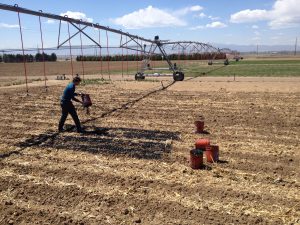
Buckets of pine wood biochar.
The activities are as follows:
- Teacher Guide
- Student activity, Graph Type A, Level 3
- Student activity, Graph Type B, Level 3
- Student activity, Graph Type C, Level 3
- PowerPoint of images
- Grading Rubric
If you walk through the lush Amazon rainforest, the huge trees may be the first thing you see. But, did you know there are wonderful things to explore on the forest floor? In special places of the Amazon, there exist incredible dark soils called “Terra Preta”. These soils are rich in nutrients that help plants grow. The main source of nutrients and dark color is from charcoal added by humans. Hundreds of years ago the indigenous people added their cooking waste, including ash from fire pits, into the ground to help their food crops grow. Today, scientists and farmers are trying out this same ancient method. When this charcoal is added to soil to help plants grow, we call it biochar.
Biochar is a pretty unique material. It is created by a special process that is similar to burning materials in a fire place, but without oxygen. Biochar can be made from many different materials. Most biochar has lots of tiny spaces, or pores, that cause it to act like a hard sponge when it is in the soil. Due to these pores, the biochar can hold more water than the soil can by itself. Along with that extra water, it also can hold nutrients. Biochar has been shown to increase crop yield in tropical places like the Amazon.
Farmers in western Colorado wanted to know what would happen if they added biochar to fields near them. Their farms experience a very different climate that is cooler and drier than the Amazon. In these drier environments, farmers are concerned about the amount of water in the soil, especially during droughts. Farmers had so many questions about how biochar works in soils that scientists at Colorado State University decided to help. One scientist, Erika, was curious if biochar could really help farms in dry Colorado. Erika thought that biochar could increase crop yield by providing pores that would hold more water in the soil that crop plants can use to grow.

Matt, a soil scientist, applying biochar to the field in a treatment plot.
To test the effects of biochar in dry agricultural environments, Erika set up an experiment at the Colorado State University Agricultural Research and Development Center. She set up plots with three different soil conditions: biochar added, manure added, and a control. She chose to include a manure treatment because it is what farmers in Colorado were currently adding to their soil when they farmed. For each treatment she had 4 replicate plots, for a total of 12 plots. She added biochar or manure to a field at the same rate (30 Megagrams/ ha or 13 tons/acre). She didn’t add anything to control plots. Erika then planted corn seeds into all 12 plots.
Erika also wanted to know if the effects of biochar would be different when water was limited compared to when it was plentiful. She set up another experimental treatment with two different irrigation levels: fullirrigationandlimitedirrigation. The full irrigation plots were watered whenever the plants needed it. The limited irrigation plots were not watered for the whole month of July, giving crops a drought period during the growing season. Erika predicted that the plots with biochar would have more water in the soil. She also thought that corn yields would be higher with biochar than in the manure and control plots. She predicted these patterns would be true under both the full and limited irrigation treatments. However, she thought that the biochar would be most beneficial when crops were given less water in the limited irrigation treatments.
To measure the water in the soil, Erika took soil samples three times: a few weeks after planting (June), the middle of the growing season (July), and just before corn harvest (September). She weighedout 10 gofmoistsoil, thendried the samples for24 hoursin an oven and weighed them again. By putting the soil in the oven, the water evaporates out and leaves just the dry soil. Sarah divided the weight of the water lost by the weight of the dry soil to calculate the percent soil moisture. At the end of the season she measured crop yield as the dry weight of the corn cobs in bushes per acre (bu/acre).
Featured scientist: Erika Foster from Colorado State University
Flesch–Kincaid Reading Grade Level = 8.9
Resources to pair with this Data Nugget:
- Biochar’s benefits may be minimal – Article from Morning Ag Clips
